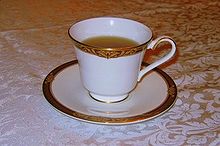Teacup


A teacup is a small cup with a handle, generally a small one that may be grasped with the thumb and one or two fingers. It is typically made of a ceramic material. It is usually part of a set, composed of a cup and a matching saucer. These in turn may be part of a tea set in combination with a teapot, cream jug, covered sugar bowl and slop bowl en suite. Teacups are wider and shorter than coffee cups.
Some collectors acquire numerous one-of-a-kind cups with matching saucers. Better teacups typically are of fine white translucent porcelain and can be decorated with floral patterns. They may also memorialize a location, person, or event. Such collectors may also accumulate silver teaspoons. These usually have a decorated enamel insert in the handle with similar themes.
The first small cups specifically made for drinking the new beverage tea seen in Europe were exported from the Japanese port of Imari. Oddly enough, there is no word in the Japanese language for "teacup", it translates as "that which is without, but with".[citation needed] Tea bowls in the Far East did not have handles, and the first European imitations, made at Meissen, were without handles, too.
Chinese teacups are very small, normally can hold no more than 30ml of liquid. They are designed to be use with YiXing teapots or Gaiwan.[1]
